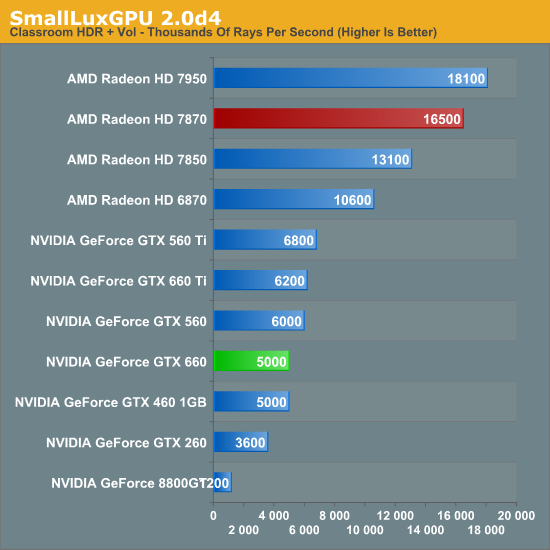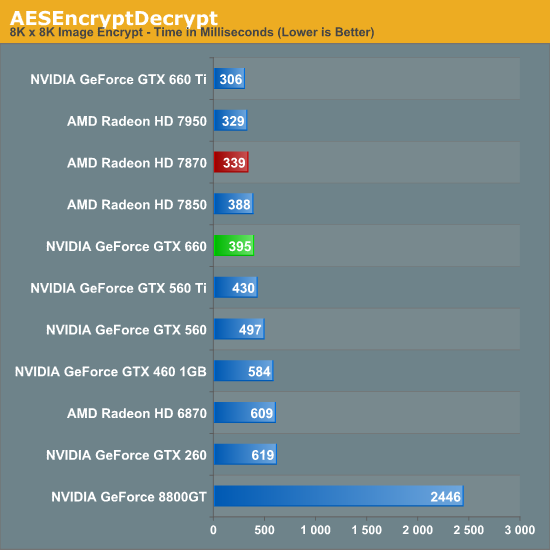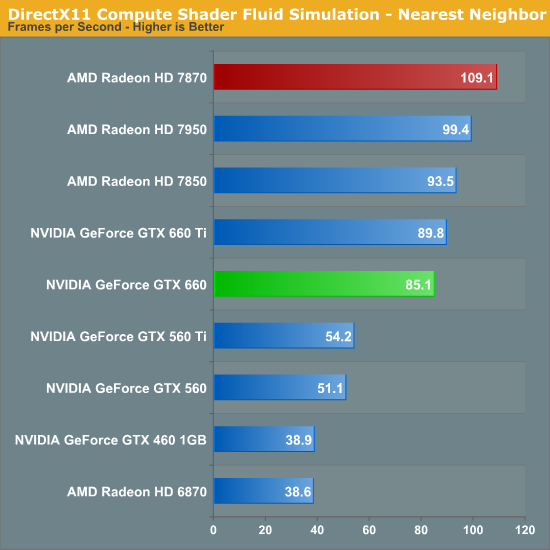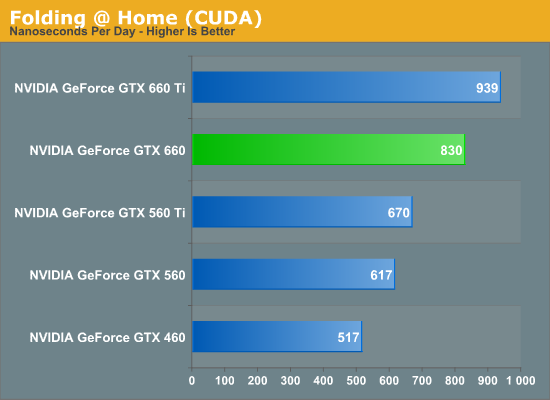The NVIDIA GeForce GTX 660 Review: GK106 Fills Out The Kepler Family
by Ryan Smith on September 13, 2012 9:00 AM ESTCompute Performance
As always our final set of real-world benchmarks is composed of a look at compute performance. As we have seen with GTX 680 and GTX 670, Kepler appears to be significantly less balanced between rendering and compute performance than GF110 or GF114 were, and as a result compute performance suffers. Further compounding this is the fact that GK106 only has 5 SMXes versus the 8 SMXes of GK104, which will likely further depress compute performance.
Our first compute benchmark comes from Civilization V, which uses DirectCompute to decompress textures on the fly. Civ V includes a sub-benchmark that exclusively tests the speed of their texture decompression algorithm by repeatedly decompressing the textures required for one of the game’s leader scenes. Note that this is a DX11 DirectCompute benchmark.

It’s interesting then that despite the obvious difference between the GTX 660 and GTX 660 Ti in theoretical compute performance, the GTX 660 actually beats the GTX 660 Ti here. Despite being a compute benchmark, Civlization V’s texture decompression benchmark is more sensitive to memory bandwidth and cache performance than it is shader performance, giving us the results we see above. Given the GTX 660 Ti’s poor showing in this benchmark this is a good thing for NVIDIA since this means they don’t fall any farther behind. Still, the GTX 660 is effectively tied with the 7850 and well behind the 7870.
Our next benchmark is SmallLuxGPU, the GPU ray tracing branch of the open source LuxRender renderer. We’re now using a development build from the version 2.0 branch, and we’ve moved on to a more complex scene that hopefully will provide a greater challenge to our GPUs.

SmallLuxGPU sees us shift towards an emphasis on pure compute performance, which of course is going to be GTX 660’s weak point here. Over 2 years after the launch of the GTX 460 and SLG performance has gone exactly nowhere, with the GTX 460 and GTX 660 turning in the same exact scores. Thank goodness the 8800GT is terrible at this benchmark, otherwise the GTX 660 would be in particularly bad shape.
It goes without saying that with the GTX 660’s poor compute performance here, the 7800 series is well in the lead. The 7870 more than trebles the GTX 660’s performance, an indisputable victory if there ever was one.
For our next benchmark we’re looking at AESEncryptDecrypt, an OpenCL AES encryption routine that AES encrypts/decrypts an 8K x 8K pixel square image file. The results of this benchmark are the average time to encrypt the image over a number of iterations of the AES cypher.

Our AES benchmark was one of the few compute benchmarks where the GTX 660 Ti had any kind of lead, but the significant loss of compute resources has erased that for the GTX 660. At 395ms it’s a hair slower than the 7850, never mind the 7870.
For our next benchmark we’re looking at AESEncryptDecrypt, an OpenCL AES encryption routine that AES encrypts/decrypts an 8K x 8K pixel square image file. The results of this benchmark are the average time to encrypt the image over a number of iterations of the AES cypher.

The fluid simulation is another benchmark that includes a stronger mix of memory bandwidth and cache rather than being purely dependent on compute resources. As a result the GTX 660 still trails the GTX 660 Ti, but by a great amount. Even so, the GTX 660 is no match for the 7800 series.
Finally, we’re adding one last benchmark to our compute run. NVIDIA and the Folding@Home group have sent over a benchmarkable version of the client with preliminary optimizations for Kepler. Folding@Home and similar initiatives are still one of the most popular consumer compute workloads, so it’s something NVIDIA wants their GPUs to do well at.

As we’ve seen previously with GK104, this is one of the few compute benchmarks that shows any kind of significant performance advantage for Little Kepler compared to Little Fermi. GTX 660 drops by 12% compared to GTX 660 Ti, but this is still good enough for a 60% performance advantage over GTX 460.










147 Comments
View All Comments
Jumangi - Thursday, September 13, 2012 - link
LOL way to try and spin AMD fanboy. The 660 is the equal of a 7870. It beats it in several tests and loses by a little in others. The $229 price is correct.Go qq somewhere else AMD dude.
Jamahl - Thursday, September 13, 2012 - link
Actually if you read anywhere else you'll find that the 7870 wins by 5-10% in the vast majority of cases.Samus - Thursday, September 13, 2012 - link
I'll take Anandtech reviews over any other reviews. This site has a 15 year reputation for truth.Jamahl - Thursday, September 13, 2012 - link
You do that. Most other people would take the average of all the reviews, and when they did that they'd realise that once again Anandtech is an outlier for Nvidia.rarson - Friday, September 14, 2012 - link
Anandtech lost that reputation years ago when everything started sounding pro-Intel/Nvidia/Apple.RussianSensation - Thursday, September 13, 2012 - link
Raghu78 is actually right."Overall the new ASUS GeForce GTX 660 DirectCU II seems to compete well with a price comparative factory overclocked Radeon HD 7870. While the gameplay experience is mostly the same between the two video cards, for the most part the factory overclocked Radeon HD 7870 seems to take the performance lead. If you look back at every game, the overclocked Radeon HD 7870 is on top in terms of raw performance,"
http://www.hardocp.com/article/2012/09/13/asus_gef...
Given that NV is 7 months late, all they did here was just barely match the price/performance of a 7 months old part. Hard to get excited about that when it's mid-September 2012 and HD8000 series isn't far off now.
HisDivineOrder - Friday, September 14, 2012 - link
Geforce 660 MSRP is $230. Radeon 7870 MSRP is $250. And if you're saying that the Geforce launch is unimpressive then you're probably ignoring the fact that AMD ignored price drops for the 78xx series cards for many, many months and only just when the info about the 660 and 660 Ti began to show up did they start aggressively lowering their pricing.So... what's impressive about nVidia's parts is that they brought competition which drove AMD to lower pricing so much you could today say there's nothing impressive about nVidia's pricing.
And that's what's impressive about it. You should be thanking nVidia for finally showing up to the competition.
Also, saying the "HD8000 series isn't far off now" is disingenuous if that line follows the same model as the 7000 series and staggers the launch so the low end comes midway through or at the end of 1Q 2013. We're not talking about the high end. We're talking about the mainstream variants.
And, if you truly believe your rhetoric, then AMD will price those parts as high or higher than the 78xx series showed up with in order to milk the market while nVidia's not able to keep up. So those cards again won't matter much since they won't be anywhere near the same price as these mid-$200 cards.
We don't even know if AMD won't milk this gen a while longer than they did prior generations because their strategy seems very different than the one they've used for quite a while. And with nVidia coming so late in this gen, AMD might see advantage in riding it out with parity and lower prices (while building up inventory of HD8k) to clean out their old stock.
Then one day after first quarter 2013, WHAM! HD8000 arrives in force. nVidia employees throughout the world look up from typing biased forum posts in every forum you visit and almost weep as cards in every bracket suddenly appear in the marketplace, but then a ray of hope shines through the darkness...
AMD priced everything high again. Angels sing and as Chuck Norris descends upon the clouds of awesomeness and badassness... GK110 arrives in his wake.
Ahhhh... I like this guessing game about what will happen with next gen thing.
raghu78 - Thursday, September 13, 2012 - link
buzz off . the majority of the reviews on the web show the HD 7870 to be faster.http://www.computerbase.de/artikel/grafikkarten/20...
http://ht4u.net/reviews/2012/nvidia_geforce_gtx_66...
http://www.hardware.fr/articles/876-21/recapitulat...
http://www.techpowerup.com/reviews/ASUS/GeForce_GT...
http://www.tomshardware.com/reviews/geforce-gtx-66...
http://www.hardocp.com/article/2012/09/13/asus_gef...
http://www.xbitlabs.com/articles/graphics/display/...
Margalus - Thursday, September 13, 2012 - link
I selected one random choice from your links, techpowerup. Guess what, the page you linked shows the 660 has higher performance per dollar than the 7870 at all resolutions except 2560x1600Galidou - Saturday, September 15, 2012 - link
Fun stuff, he said the ''majority'' and you look at only one of the links he sends. Replying the way you did is a little disrespectful. Next time just write: ''too long didn't read, this card ownz''.